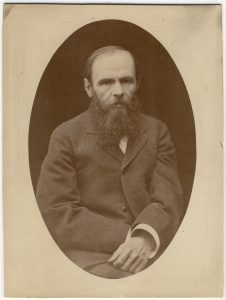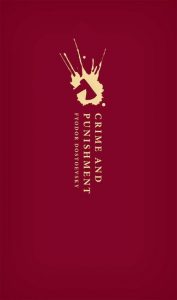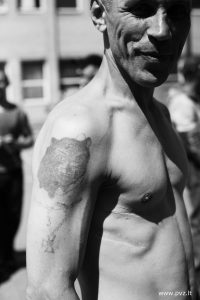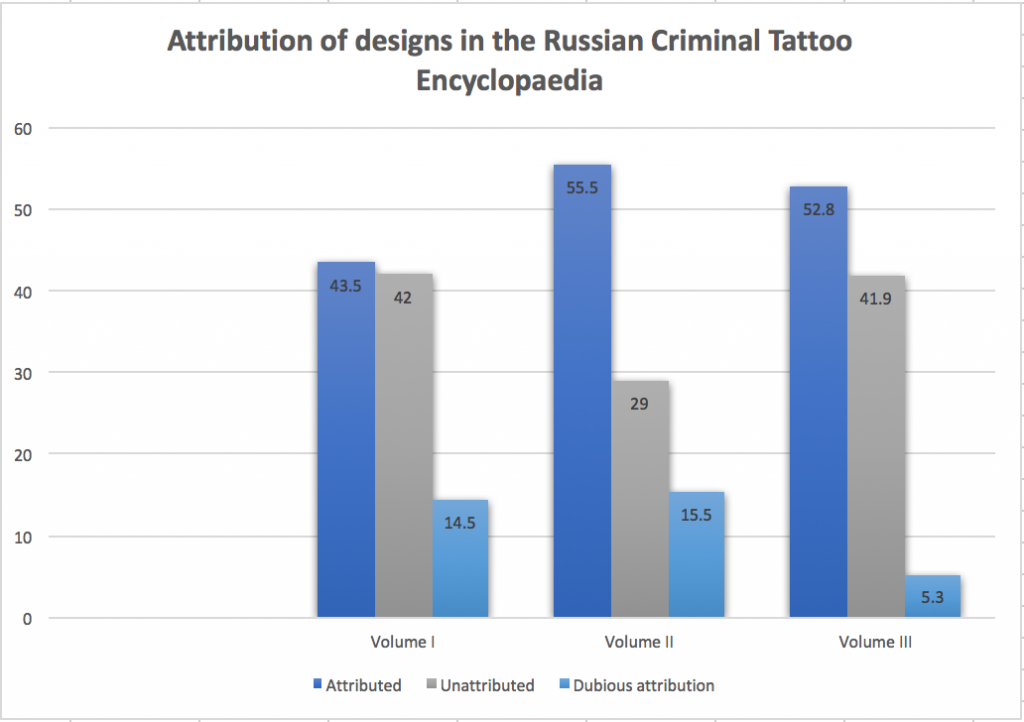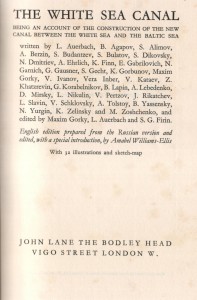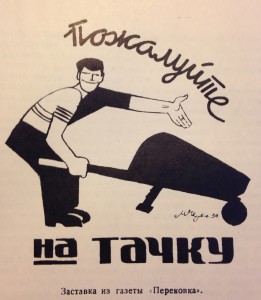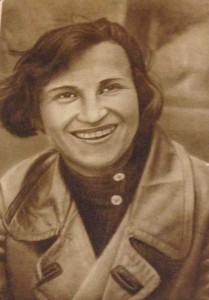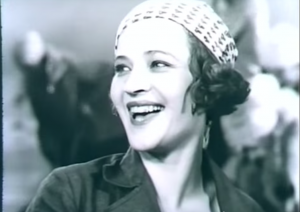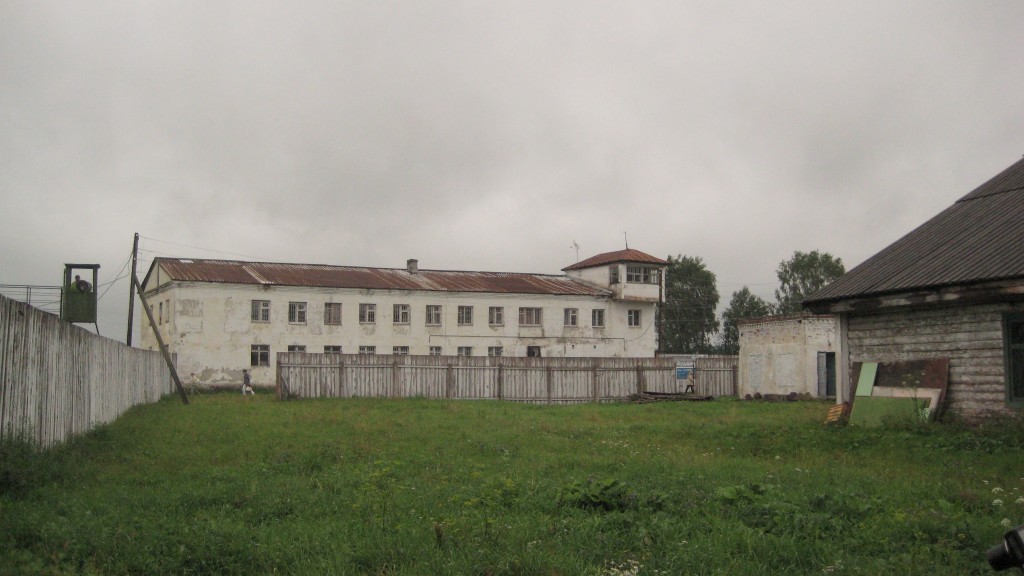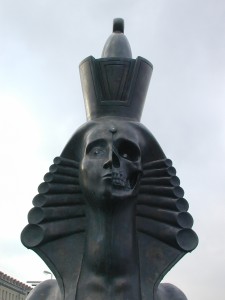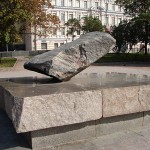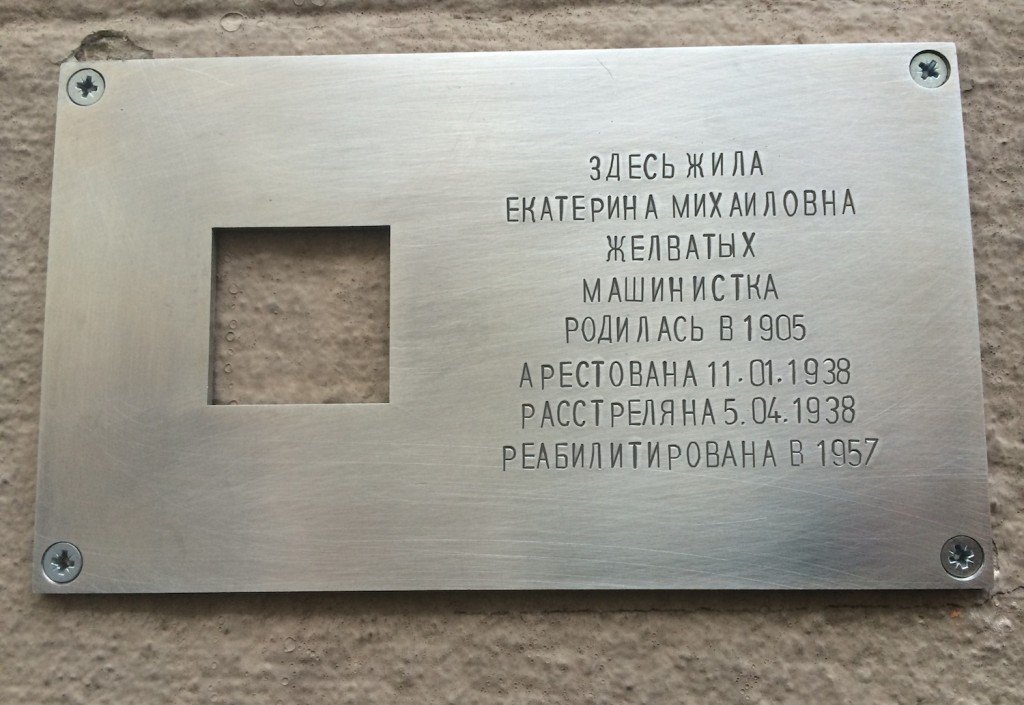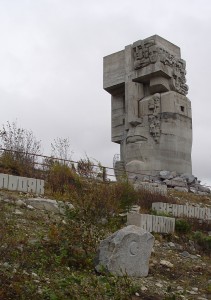
Mask of Sorrow. Monument to the victims of the Gulag, Magadan, by Alglus (CC BY-SA 3.0)
I’ve been thinking about historical memory of the Gulag and the Stalinist repressions recently whilst working on my book, and have decided to put together a few posts of links relating to the subject. This is partly from my own need to organize the material coherently, and partly because an up-to-date list would, I hope, be useful to other people as well.
I’ll say a bit more about the question of historical memory itself in a subsequent post, because there is already quite enough material for this one, on memory books. Memory books (knigi pamiati), listing the names of victims of the political repressions in the Soviet Union, began to appear in the mid 1990s. The bibliography A. Ia. Razumov et al, eds, Knigi pamiati zhertv politicheskikh repressii v SSSR: Annotirovannyi ukazatel’ (St Petersburg: RNB, Mezhdunarodnyi proekt “Vozvrashchennye imena”, 2004) (pdf version also here) shows just how many of these books there are – and this includes material only up to 2003. They are still appearing, albeit at a much slower rate – some recent ones are listed on the Vozvrashchennye imena (Recovered names) website. A significant number of memory books and databases have also been put on line, primarily, although not solely, through the auspices of Memorial and the Vozvrashchennye imena project, which ultimately aims (I hope it is not too optimistic to continue to use the present tense) to build a single database of all the victims of the Soviet repressions. That is clearly no small task, and the long gestation of the project should perhaps come as no surprise. In the mean time it is part of the nature of the internet that sites get moved and links decay, and even the links sections on the Memorial and Vozvrashchennye imena websites are full of broken links, making it difficult to find some of those memory books that are currently available.
My starting point for compiling this list was the following sites:
Возвращенные имена [ebooks by the Recovered Names project] and other links.
Мемориал: СПИСОК КНИГ ПАМЯТИ: Книги, составленные по региональному признаку [Memorial’s List of memory books compiled by region] and СПИСКИ ЖЕРТВ ПОЛИТИЧЕСКИХ РЕПРЕССИЙ [lists of victims of political repressions].
Возвращенные имена-списки ссылок [A further list of references based on the Vozvrashchennye imena materials].
I have updated numerous links from these lists, removed those that are broken when I haven’t been able to find replacements (those that were part of the Okrytaia russkaia elektronnaia biblioteka – OREL – seem to have disappeared altogether with the demise of that project), and added a couple of extra ones I found whilst compiling the list. I make no claims to completeness – the list is very much a work in progress, and any information about other memory book sites that can be added will be gratefully received. The material is ordered thus:
1) General lists and databases
2) Lists of victims by location:
a) Moscow
b) Leningrad
c) other cities and regions of the Russian Federation
d) other former Soviet republics
e) other countries and peoples
3) Lists devoted to specific groups of victims
I have translated titles and essential details about contents. In places I have included notes about sources, usage, limitations, etc, based on my own observations, but overall I have tried to keep details to a minimum, given the number of links.
1) General lists and databases
ЭЛЕКТРОННАЯ КНИГА ПАМЯТИ “ВОЗВРАЩЕННЫЕ ИМЕНА”: “Жертвы политического террора в СССР”: списки [Electronic memory book Recovered Names: Victims of political terror in the USSR]. Includes the names of victims who do not appear in other memory books, based on materials received from relatives and taken from archival sources in the ‘Vozvrashchennye imena’ Centre at the Russian National Library (RNB). Contains around 2,700,000 names. Browsable lists by surname.
Общероссийская общественная благотворительная организация инвалидов — жертв политрепрессий: РОССИЙСКАЯ АССОЦИАЦИЯ ЖЕРТВ НЕЗАКОННЫХ ПОЛИТИЧЕСКИХ РЕПРЕССИЙ [All-Russian social charitable organization for invalids and victims of political repression: Russian Association for the victims of the illegal political repressions]. Database.
Сталинские расстрельные списки [Stalin’s execution lists] Lists of citizens sentenced by Stalin and his closest circle. From the CD “Stalinskie rassstrelnye spiski” (Moscow: Zven’ia, 2002). Browsable lists by name and place.
Объединенная база данных по Москве, Твери, Туле и Карелии [Combined database for Moscow, Tver, Tula and Karelia] C. 48,000 names.
2) Lists of victims by location
a) MOSCOW
МОСКОВСКИЙ МАРТИРОЛОГ: Списки расстрелянных по политическим обвинениям в годы советской власти [Moscow Martyrology: Lists of people executed on political charges in the years of Soviet power] Compiled by Memorial. Also has information on Sentencing organs; sources of information and preparation of the list; places of mass burial of the victims of political repressions; principles of publication. Organized by place of burial and year of execution:
Яузская больница (Yauzskaya hospital)
Ваганьковское кладбище (Vaganskoe cemetery)
Донское кладбище (Donskoe cemetery)
Бутово (Butovo firing range) From the publication: Мартиролог расстрелянных и захороненных на полигоне НКВД “Объект Бутово”. 08.08.1937–19.10.1938. М.; Бутово, 1997 [Martyrology of people shot and buried in the NKVD Butovo firing range]
Коммунарка (Kommunarka).
Мартиролог жертв политических репрессий, расстрелянных и захороненных в Москве и Московской области в 1918-1953 гг. [Martyrology of victims of the political repressions, shot and buried in Moscow and the Moscow oblast, 1918-1953]. The Sakharov Center’s Martyrology, browsable by surname.
Расстрелы в Москве [Shot in Moscow]. Memorial’s list, organized street by street. A map of the victims by address can be found here.
b) LENINGRAD
Ленинградский мартиролог: Списки граждан, расстрелянных в Ленинграде, вне Ленинграда и впоследствии реабилитированных [Leningrad martyrology: lists of citizen shot in and around Leningrad and subsequently rehabilitated, 1937-1938]. Some interesting statistics related to this list can be found here, which give the lie, among other things, to the persistent notion that it was mainly party members who were arrested during the Great Terror.
c) RUSSIAN FEDERATION (alphabetical order by city/region)
ALTAI: Memorial Алтайский край
From the publication: Жертвы политических репрессий в Алтайском крае. Т. 1: 1919–1930. (Барнаул, 1998) [Victims of political repression in the Altai krai, vol. 1, 1919-1930].
AMUR: site of the Amur oblast’s administration:
Книга памяти жертв политических репрессий Амурской области. Т. 1–2.— Благовещенск, 2001–2003. [Book of memory of the victims of political repressions in Amur oblast, Vols. 1-2].
ARKHANGELSK: Мартиролог Соловецких узников [Martyrology of Solovki prisoners, on the Solovki Encyclopedia website].
See also Репрессии в Архангельске: 1937–1938. Документы и материалы.— Архангельск, 1999. [Repressions in Arkhangelsk: 1937-1938. Documents and materials] Downloadable pdf, also available here.
ASTRAKHAN: site of the Astrakhan oblast’s administration:
Из тьмы забвения: Книга памяти жертв политических репрессий: Российская Федерация. Астраханская область. Комис. по восстановлению прав реабилитир. жертв полит. репрессий Астрах. обл.; Рабочая группа: Ю. С. Смирнов (отв. ред.), В. В. Волков и др.— Астрахань: Волга. [From the darkness of oblivion: Book of memory of the victims of political repression: Russian Federation. Astrakhan oblast/Commission for the restoration of rights of the rehabilitated victims of political repression in the Astrakhan oblast].
Т. 1: 1918–1954: А-Я.— 2000.
Т. 2: 1918–1986: А-Я.— 2003.
10,955 names.
NB: The original page containing this memory book seems to have disappeared but it is available on the internet archive.
BASHKORTOSTAN: Книга памяти жертв политических репрессий Республики Башкортостан. Т. 1, 2. (Уфа, 1997–1999). [Memory book of the victims of political repressions in the Republic of Bashkortostan].
VLADIMIR: site of the Vladimir oblast’s administration: Боль и память: Книга памяти жертв политических репрессий Владимирской области. [Pain and Memory: Memory Book of the victims of political repressions from the Vladimir oblast]
Т. 1 [г. Владимир; р-ны Александровский—Кольчугинский].— 2001. [Vol. 1: Vladimir city; Aleksansdrovskii-Kol’chuginskii regions]
Т. 2 [р-ны Меленковский—Юрьев-Польский и дополнительные списки по Александровскому—Кольчугинскому р-нам].— 2003 [Melekovskii-Iur’ev-Pol’skii and additional lists for the Aleksansdrovskii-Kol’chuginskii regions]
11,205 biographical notes in all. Searchable by surname, name and patronymic]. Downloadable documents – also available here.
VOLOGDA: Official portal of the Government of Vologda oblast: Книга памяти [Memory book].
VORONEZH: Воронежская область
From information provided to Voronezh Memorial by the directorate of the Voronezh FSB.
IRKUTSK: Site of the Irkutsk Association for the victims of political repressions: Памяти жертв политических репрессий [Memory book of victims of political repressions] The database corresponds to part of the first volume of the Memory book Zhertvy politicheskikh repressii Irkutskoi oblasti: Pamiat’ i preduprezhdenie budushchemu. More than 1500 biographical entries (from Abagaev Aleksandr Toktoevich to Bashkuev Lazar’ Sharaevich). Search by alphabet.
KEMEROVO: Книга памяти жертв политических репрессий Кемеровской области. Т. 2.– Кемерово, 1996. [Memory book of the victims of political repressions in Kemerovo oblast].
NB: this is a downloadable .rar file.
KOMI REPUBLIC: Memorial Республика Коми
From the publication: Покаяние: Коми республиканский мартиролог жертв массовых политических репрессий. Т. 1. (Сыктывкар, 1998) [Redemption: the Komi Republic’s martyrology of the victims of mass political repressions]
KRASNODARSK: on Krasnodarsk Memorial Society’s site: интернет-проект “Трагические судьбы — возвращенные имена” Книга памяти Кубани [Internet project ‘Tragic Fates: Recovered names’: A Book of memory of the Kuban]. More than 26,000 names.
KRASNOYARSK: Krasnoyarsk Memorial Society’s site Сайт Красноярского общества “Мемориал”. Мартиролог (биографические справки, фото). Доступ по алфавиту имен. Книга памяти жертв политических репрессий Красноярского края [Martyrology (biographical entries, photos). Access via alphabetized names. Memory book of political repressions in Krasnoyarsk krai]. Covers letters А – К.
Кн. 1: [А – Б]
Кн. 2: [В – Г]
Кн. 3: [Д – И]
Кн. 4: [К].
KURGAN: Memorial Курганская область
From the publication: Осуждены по 58-й: Книга памяти жертв политических репрессий Курганской области. Т. 1. (Курган, 2002) [Sentenced under article 58: Memory book of political repressions in Kurgan oblast]
KURSK: Книга памяти жертв политических репрессий Курской области. Т. 3.— Курск, 2000. [Memory book of political repressions in Kursk oblast].
LIPETSK: Memorial Липецкая область
From the publication: Помнить поименно: Книга памяти жертв политических репрессий Липецкого края с ноября 1917 года. Т. 1.— (Липецк, 1997). [To remember by name: Memory book of political repressions in Lipetsk krai from November 1917. Volume 1-].
MAGADAN: Memorial Магаданская область
From the publication За нами придут корабли: Список реабилитированных лиц, смертные приговоры в отношении которых приведены в исполнение на территории Магаданской области. (Магадан, 1999) [Ships came for us. Lists of rehabilitated people whose death sentences were carried out in the territory of Magadan oblast] Biographical details of 7,546 repressed people.
MARI EL REPUBLIC: Memorial Республика Марий Эл
From the publication Трагедия народа: Книга памяти жертв политических репрессий Республики Марий Эл. В 2 томах. (Йошкар-Ола, 1996–1997) [The Tragedy of a People: Memory book of the victims of political repression in the Mari El Republic].
NIZHNY TAGIL: Memorial Нижний Тагил
From the publication: Жертвы репрессий. Нижний Тагил. 1920–1980-е годы. (Екатеринбург, 1999) [Victims of Repression: Nizhny Tagil, 1920s-1980s].
OMSK: Забвению не подлежит: Книга памяти жертв политических репрессий Омской области. Т. 1: А—Б.— (Омск, 2000). [Not to be forgotten: Memory book of victims of political repression in Omsk oblast]
NB: The downloadable pdf on this page is corrupted, but it is just about readable online, albeit not in the most convenient form.
ORENBURG: Книга памяти жертв политических репрессий в Оренбургской области.— Калуга, 1998. [Memory book of victims of political repressions in Orenburg oblast].
ORLOV: Реквием: Книга памяти жертв политических репрессий на Орловщине. Т. 1–4. Орел, 1994–1998. [Requiem: Memory book of victims of political repressions in the Orlovshchina]
NB: the encoding of this page needs to be set to Cyrillic-1251.
PENZA: Site of the Penza “Memorial” Society: Список реабилитированных жертв репрессий в разделе Книга памяти. [List of rehabilitated victims of repressions from the Memory book].
new: PERM: Пермский край / Пермская область: Годы террора: электронная Книга памяти жертв политических репрессий [Years of Terror: electronic memory book of victims of the political repressions] on Perm Memorial’s website. This is a very impressive recently published site with a great deal of information about the terror and its victims, as well as a martyology with biographical details of victims, searchable indexes by name and geographical area and much more besides.
See also: Картотека репрессированных на сайте Пермского Государственного архива. [Card index of the repressed on website of the Perm State archive].
RYAZAN: На сайте Рязанского общества защиты прав человека. [Site of the Ryazan Society for the Defence of Human Rights]. Searchable by place as well as name; useful site with information also on cemeteries, memorials, etc.
SAMARA: Memorial Самарская область
From the publication: Белая книга о жертвах политических репрессий. Самарская область. Т. 1–7. (Самара, 1997–1998) [The White book of victims of political repressions: Samara oblast]
See also the Index of Samara families, which covers letters А-Л.
SARATOV: Memorial Саратовская область
From information made available by the Saratov FSB directorate.
SVERDLOVSK: Memorial Свердловская область
From the publication: Книга памяти жертв политических репрессий. Свердловская область. Т. 1. (Екатеринбург, 1999) [Memory book of the victims of political repressions.] Covers letters А-Б only; vols 2-3, covering В-Д and Е-И not yet online.
SMOLENSK: website of the Administration of Smolensk oblast: Электронная картотека жертв политических репрессий Смоленской области, 1917–1953 гг. [Electronic card index of the victims of political repression in Smolensk oblast]
29,508 entries. Search via database only, no browsing of lists. A significant number of duplicates. Part of the database is based on the publication: По праву памяти: Книга памяти жертв незаконных политических репрессий: А — Я. (Смоленский мартиролог; Т. 1); Книга памяти жертв политических репрессий: А — С. (Смоленский мартиролог; Т. 2–5). [By right of memory: Memory book of the victims of illegal political repressions: А—Я (Smolensk martyrology vol. 1); Memory book of the victims of political repressions, А—С (Smolensk martyrology vols 2-5)].
TATARSTAN: Memorial Республика Татарстан
Electronic version of the publication: Книга памяти жертв политических репрессий. Республика Татарстан. Т. 1–5.— Казань, 2000–2002) [Memory book of victims of political repressions]. Vols 1-5 of the print edition cover letters А-З; the electronic version so far covers letters А-Е only.
TOMSK: Memorial museum “NKVD Investigative prison”: Томский мартиролог
Книга Памяти (Банк данных жертв политических репрессий Томской области). [Tomsk martyrology: Memory book (data base of victims of political repression in the Tomsk oblast)].
List of 31,989 people deprived of electoral rights and dekulakized in the 1920s-1930s, from materials in the Tomsk oblast state archives. References to archive file numbers. List of 34,000 families (around 190,000 individuals) of special settlers [spetspereselentsev] – dekulakized peasants and members of deported ethnic groups sent to Tomsk oblast in the 1930s-1950s, and rehabilitated in the 1990s. From data of the Information Centre of the Tomsk oblast Directorate of Internal Affairs. List of 20,806 rehabilitated inhabitants of Tomsk oblast (repressed under article 58 of criminal code of the RSFSR). From data of the administration of the Tomsk oblast KBG-FSK-FSB. This list, but with less information on each of the repressed, was first set down in the publication Боль людская: Книга памяти томичей, репрессированных в 30–40-е и нач. 50-х гг. Т. 1–5.— Томск, 1991–1999 [Human Pain: Memory book of Tomsk residents repressed in the 1930s-1940s and beginning of the 1850s].
See also: На сайте Института экономики и организации промышленного производства СО РАН: Список репрессированных жителей рабочего поселка Могочино Томской области (по книге Боль людская) Site of the Institute of Economics and Industrial Engineering, Siberian branch of the Russian Academy of Sciences: List of repressed inhabitants of Mogochino workers’ settlement in Tomsk oblast (from Bol’ liudskaia).
TVER: Memorial Тверская область
From the database, an earlier version of which was set down in the publication: Книга памяти жертв политических репрессий Калининской области. Т. 1: Мартиролог. 1937–1938. (Тверь, 2000) [Memory book of victims of political repression in Kalinin oblast].
TULA: Memorial Тульская область
From the database, an earlier version of which was set down in the publication: Книга памяти жертв политических репрессий в Тульской области. 1917–1987 гг. Т. 1.— (Тула, 1999) [Memory book of victims of political repression in Tula oblast].
TYUMEN: Memorial Тюменская область. Ханты-Мансийский округ [Khanti-Mansiikii district]. Ямало-Ненецкий (б. Остяко-Вогульский) округ [Iamalo-Nenetskii (Bolshoi Ostriako-Vogul’skii) district].
From the publication: Книга расстрелянных: Мартиролог погибших от руки НКВД в годы большого террора (Тюменская область): В 2 томах. (Тюмень, 1999) [Book of the executed: Martyrology of those who died at the hands of the NKVD in the years of the Great Terror (Tyumen oblast)] [Tyumen, Ishimskii, Iamalo-Nenetskii, Ostriako-Vogul’skii, Tolbolsk operational sectors of the NKVD].
UDMURT REPUBLIC: Книга памяти жертв политических репрессий: Удмуртская республика. Ижевск, 2001. [Memory book of the victims of political repressions: Udmurt Republic].
ULYANOVSK: Ульяновская область
From the publication: Книга памяти жертв политических репрессий. Ульяновская область. Т. 1. (Ульяновск, 1996) [Memory book of victims of political repression].
New: VOLGOGRAD (Stalingrad): Волгоград (Сталинград)
Петля 2: воспоминания, очерки, документы (Noose-2: memoirs, sketches, documents), ed. Iu. Beledin (Volgograd, 2000), pp. 367-398. A list of more than 700 names of those repressed from the Stalingrad oblast. A scanned copy, so not the most usable format, but at least it’s available.
YAROSLAVL: Ярославская область
Не предать забвению [Not to be consigned to oblivion: website of the Yaroslavl Memorial Society and regional Commission for the restitution of right of the victims of political repressions]. List of more than 1800 victims executed during the political repressions.
d) FORMER SOVIET REPUBLICS
BELARUS: Индекс уроженцев Беларуси, репрессированных в 1920-1950-е гг. в Западной-Сибири [Index of natives of Belarus repressed 1920s-1950s in western Siberia].
KAZAKHSTAN: Memorial Казахстан. Алма-Ата
From the publication: Книга скорби = Азалы кiтап. Расстрельные списки. Вып. 1: Алма-Ата, Алма-Атинская область (Алматы, 1996) [Book of Sorrow. Execution lists. Issue 1: Alma-Ata & Alma-Ata oblast].
See also: Музейно-мемориальный комплекс жертв политических репрессий и тоталитаризма “АЛЖИР”: Список узниц АЛЖИРа в порядке алфавита по национальностям [ALZHIR Museum-Memorial Complex of the victims of political repressions and totalitarianism: list of ALZHIR prisoners in alphabetical order by nationality], and список женщин-узниц лагеря «алжир» [list of female prisoners at the ALZHIR camp].
UKRAINE: Національний банк даних жертв політичних репресій радянської доби в Україні [National database of victims of political repressions of the Soviet era in Ukraine]
Реабілітовані історією [Rehabilitated History. Database. Alphabetical search. More than 41,000 names].
Memory books by region (not updated since recent geopolitical upheavals):
Автономна Республіка Крим Autonomous Republic of Crimea
Вінницька область Vinnytsia oblast
Дніпропетровська область Dnipropetrovsk oblast
Донецька область Donetsk oblast
Житомирська область Zhytomyr oblast
Закарпатська область Zakarpattia oblast
Київська область Kyiv oblast
Львівська область Lviv oblast
Миколаївська область Mykolaiv oblast
Рівненська область Rivne oblast
Тернопільська область Ternopil oblast
Харківська область Kharkiv oblast
Херсонська область Kherson oblast
Хмельницька область Khmelnytskyi oblast
Чернівецька область Chernivtsi oblast
Чернігівська область Chernihiv oblast
Lviv society “Poshuk”: Список расстрелянных в 1940–1941 гг. [Lists of the executed, 1940-41] Жертвы львовской тюрьмы №3 (г. Золочев) [Victims of Lviv prison no. 3 (Zolochev)] From the publication: Романів О. М., Федущак І. В. Західноукраїнська трагедія, 1941. Наукове товариство ім. Шевченка, Фундація Українського вільного ун-ту в США.— Львiв; Нью Йорк, 2002. [Romaniv O., Fedushchak I., A Western Ukrainian tragedy, 1941. Shevchenko scientific society, Foundation of the Ukrainian Free University in the USA].
ESTONIA: Сайт Фонда Кистлер-Ритсо ЭЭСТИ (КРЭС). [Site of the Kistler-Ritso EESTI (KRES) Society] In Estonian and Russian. Virtual version of the Museum of Occupation in the period between 1940 and 1991. Lists of the repressed in Estonia. 35,165 names, from the publication: Politilised arreteerimised Eestis, 1940–1988. Koide 1–2. Tallinn, 1996, 1998. [Political arrests in Estonia, 1940–1988], with links to further editions.
e) OTHER COUNTRIES AND PEOPLES
GERMANY: На сайте российских эмигрантов в Нюрнберге: “Советские немцы — узники Тагиллага”. [Website of Russian emigrants in Nuremberg: Soviet Germans – prisoners of Tagillag] Electronic database (6500 names) by the laboratory of historical information technology of the Nizhny Tagil state social pedagogical academy. Created from a card index of labour army workers at Tagillag.
POLAND: Центр “Карта” | Ośrodek KARTA: Information on Polish citizens repressed in the USSR, including executed prisoners of war. Search by database. Information on the multi-volume publication “Indeks Represjonowanych”. In Polish.
Списки репрессированных поляков Lists of Poles incarcerated in the camps at Borovich and Stalinogorsk, plus some statistics and analytical articles.
Katyn massacre: Мемориальный комплекс “Катынь” [Katyn Memorial Complex].
CHINESE VICTIMS: Perm
список граждан китайской национальности, репрессированных по политическим мотивам в Пермской области в 1930-1950 гг. (по документам Государственного общественно-политического архива Пермской области, переданным из РУ ФСБ РФ по Пермской области) [List of citizens of Chinese nationality repressed for political reasons in Perm oblast in 1930-1950].
3) GROUPS OF VICTIMS
PRIESTS AND OTHER RELIGIOUS VICTIMS
Православный Свято-Тихоновский гуманитарный Университет: Канонизированные новомученики и исповедники Русской Православной Церкви. Orthodox Humanities University of St Tikhon: Canonized new martyrs and confessors of the Russian Orthodox Church. More than 28,000 entries. Biographies, photos, information about repressions, links to sources. Search by name, place of service etc. Also statistics of repression by city/region and date.
NB: Both pages need the encoding set to Cyrillic (Windows-1251).
Книги игумена Дамаскина (Орловского) “Мученики, исповедники и подвижники благочестия Русской Православной Церкви ХХ столетия: Жизнеописания и материалы к ним”; (Тверь: Булат): [The book of Igumen Damaskin (Orlovskii) Martyrs, confessors and persons of faith and devotion of the Russian Orthodox Church of the 20th Century: Biographies and Materials] Details of over 900 martyrs and repressed religious figures from all over Russia.
Lipetsk: Алфавитный список репрессированных в годы Советской власти священно- и церковнослужителей [Alphabetical list of religious figures and clerics repressed in the years of Soviet power].
Moscow – Butovo: Список священно- и церковнослужителей, пострадавших за веру и Церковь Христову в Бутово [List of religious figures and clerics who suffered for the faith and the Church of Christ at Butovo firing range].
Primorskii krai: Пострадавшие за Христа в Приморье. Вып. 1 / Владивосток. и Примор. епархия; Сост. Г. В. Прозорова.— Владивосток: Изд-во ДВГТУ, 2000. [Those who suffered for Christ in Primor’e. Issue 1] 53 names of repressed clerics, cloistered and lay people.
St Petersburg and Leningrad oblast: Санкт-Петербургский мартиролог (2002) [The St Petersburg Martyrology] – 3062 people who suffered for their faith, by denomination, with references to sources.
ACADEMICS
Scientists and academicians: Социальная история отечественной науки [The social history of Russian science] Including repressed honorary, actual and corresponding members of the Academy of Sciences, including scholars elected to the Academy after their repression. Repressed geologists (968 individual biographies). Directors, deputy directors and learned secretaries of institutes executed in Moscow (71 individual biographies). Professors and doctors of science executed in Moscow (104 individual biographies). Academics shot in Moscow (458 individual biographies). Repression of members of the Leningrad Institute of Physics and Engineering (43 individual biographies).
Vostokovedy (Far-Eastern specialists): Люди и судьбы: Биобиблиографический словарь востоковедов — жертв политического террора в советский период (1917–1991) [People and Fates: Bio-bibliographical dictionary of Far-Eastern specialists who fell victim to the political terror in the Soviet period (1917-1991). 750 names.
Artists and art historians: On the Sakharov Center’s site.
ARMY COMMANDERS PURGED IN THE 1930S
Персональный состав и репрессии командного состава РККА и КФ в 1930-е гг. (с указанием званий и должностей в 1935–36 гг.) [Personnel and repression of commanding officers of the Red Army and Red Navy in the 1930s, with indications of ranks and duties in 1935-36].
Next time: Memorials and other memory projects

